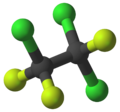Top Qs
Timeline
Chat
Perspective
1,1,2-Trichloro-1,2,2-trifluoroethane
Chemical compound From Wikipedia, the free encyclopedia
Remove ads
1,1,2-Trichloro-1,2,2-trifluoroethane, also called simply trichlorotrifluoroethane (often abbreviated as TCTFE) or CFC-113, is a chlorofluorocarbon. It has the formula Cl2FC−CClF2. This colorless, volatile liquid was a versatile solvent[5] used in various precise cleaning operations until it was phased out due its impact on the ozone layer.
Remove ads
Production
CFC-113 can be prepared from hexachloroethane and hydrofluoric acid:[6]
- C2Cl6 + 3 HF → CF2Cl−CFCl2 + 3 HCl
This reaction may require catalysts such as antimony, chromium, iron and alumina at high temperatures.[7]
Another synthesis method uses HF on tetrachloroethylene instead.[8] Industrial production of CFC-113 began in the early 1940s.[9]
Uses
Summarize
Perspective
CFC-113 was one of the three most popular CFCs, along with CFC-11 and CFC-12.[10] In 1989, an estimated 250,000 tons were produced.[5] It has been used as a cleaning agent for electrical and electronic components.[11] CFC-113’s low flammability and low toxicity made it ideal for use as a cleaner for delicate electrical-electronic equipment such as printed circuit boards, fabrics, and metals. It would not harm the product it was cleaning, ignite with a spark or react with other chemicals.[12]
It was used as a dry-cleaning solvent, as an alternative to perchloroethylene, introduced by DuPont in March 1961 as "Valclene"[13] (former designated trade name was "Fasclene"[14] but it was later changed to Valclene in the same year for legal reasons)[15][16] and was also marketed as the "solvent of the future" by Imperial Chemical Industries in the 1970s under the tradename "Arklone". Others from this series were Perklone (Tetrachloroethylene), Triklone (Trichloroethylene), Methoklone (Dichloromethane) and Genklene (1,1,1-Trichloroethane).[17][18] Its use in dry-cleaning peaked around 1971, and dry-cleaners using CFC-113 were known as Valclenerías in Spanish.[19] In 1986, 489 dry-cleaning facilities (about 2.2% of 21,787 dry-cleaning facilities) in the US were using CFC-113 as their main solvent.[20] It was seen as the perfect dry-cleaning solvent until its environmental effects were discovered.
CFC-113 in laboratory analytics and industry has been replaced by other solvents.[21]
Reduction of CFC-113 with zinc gives chlorotrifluoroethylene:[5]
- CFCl2−CClF2 + Zn → CClF=CF2 + ZnCl2
Remove ads
Hazards
Summarize
Perspective
When inhaled in large concentrations, trichlorotrifluoroethane can cause loss of consciousness.


CFC-113 is a very unreactive chlorofluorocarbon. It may remain in the atmosphere up to 90 years,[22] sufficiently long that it will cycle out of the troposphere and into the stratosphere. In the stratosphere, CFC-113 can be broken up by ultraviolet radiation (UV, sunlight in the 190-225 nm range), generating chlorine radicals (Cl•), which initiate degradation of ozone requiring only a few minutes:[23][24]
- CClF2CCl2F → C2F3Cl2 + Cl•
- Cl• + O3 → ClO• + O2
This reaction is followed by:
- ClO• + O → Cl• + O2
The process regenerates Cl• to destroy more O3. The Cl• will destroy an average of 100,000 O3 molecules during its atmospheric lifetime of 1–2 years.[11]
Aside from its immense environmental impacts, trichlorotrifluoroethane, like most chlorofluoroalkanes, forms phosgene gas when exposed to a naked flame.[25]
See also
References
Wikiwand - on
Seamless Wikipedia browsing. On steroids.
Remove ads




